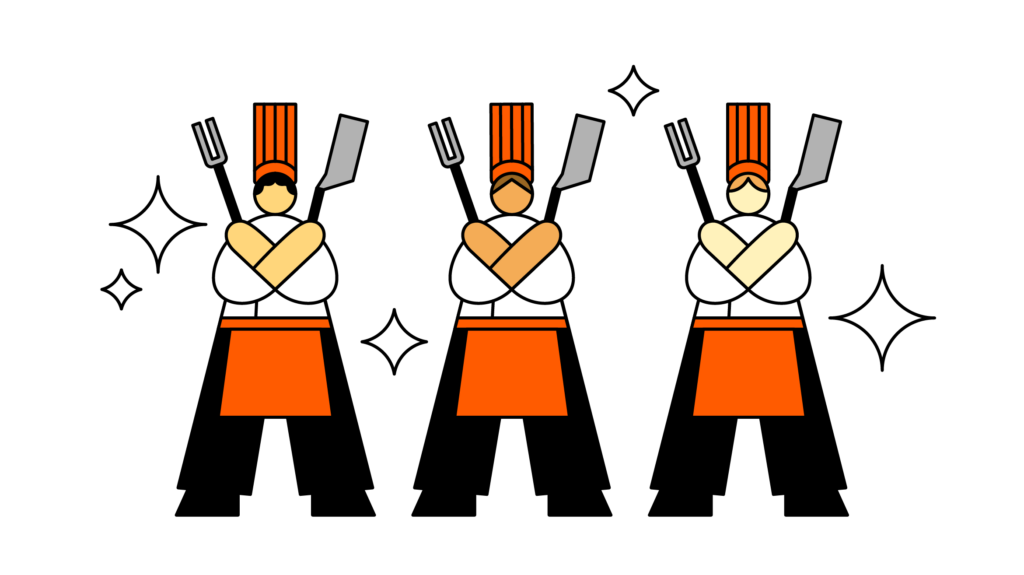
From hibachi burritos in Long Beach to halal hibachi in Queens, teppanyaki’s many iterations are distinctly American
You shut your eyes tight as a stream of sake fills your mouth, cascading from the squeeze bottle the chef is wielding across the table. To your left, a different chef is cutting the head off a chicken made of rice, and to your right, an onion ring volcano roars to life. The meal, prepared with pageantry on a flat-top grill in front of diners, brings together shrimp, chicken, or steak, rice or noodles, and an assortment of vegetables, all topped with yum yum sauce, the mayonnaise-based Japanese steakhouse staple. There’s no mistaking it: You’re at hibachi.
From New Hampshire to California, hibachi restaurants are peppered across the American restaurant landscape. Although they are rooted in Japanese culture, hibachi restaurants have become distinctly American since the iconic Benihana opened in Manhattan in 1964. Whether it’s halal hibachi in Queens or hibachi burritos in Long Beach, there is something undeniably American about hibachi’s many current iterations. It’s a cuisine that has evolved as it cemented itself in the American consciousness, becoming a symbol of the “melting pot” ethos that permeates perceptions of the US culinary scene.
Even the word “hibachi,” in its current use, is American. Traditionally, “hibachi” refers to a small vessel used to hold burning charcoal in Japan. While hibachis can be used for cooking when a small grate is placed on top of the vessel, the flat-top grill most associated with hibachi restaurants is called a teppan. The style of cooking often showcased at hibachi restaurants is referred to in Japan as “teppanyaki,” a term that has grown in prevalence stateside as the importance of perceived “authenticity” has grown in the US food scene.
Teppanyaki culture originated in post–World War II Japan, with Western-influenced meals of steak and vegetables cooked in front of guests at restaurants that drew in more foreigners than Japanese locals. As the cuisine increased in popularity, so did the chefs’ showmanship and flair. The explosion of its popularity here in the United States can be traced back to the genius of Hiroaki “Rocky” Aoki, the founder of the American outpost of the Benihana brand. In 1964, Rocky opened the first teppanyaki restaurant in New York City, named after his father’s teppanyaki restaurant in Tokyo, Benihana Bekkan.
The first review of Benihana landed in a 1964 edition of the New York Herald Tribune, written by food critic Clementine Paddleford. While Benihana fans will be happy to hear that steak and mushrooms were on the original menu, Paddleford barely mentioned the showmanship of the chefs preparing her meal, instead focusing on the fact that waitresses were “dressed in Japanese kimonos, complete with obis.” This aspect of the meal aligns more closely with sukiyaki, a hot pot restaurant model that was the most popular iteration of Japanese cuisine in America at the time. According to Dr. James Farrer, a sociology professor at Sophia University in Tokyo, the performance at sukiyaki restaurants was rooted in the act of patrons being served by Japanese women, who were often dressed as geishas.

Over time, Benihana intentionally shed any connection to sukiyaki, running ads in New York magazine with the tagline “Sorry, No Sukiyaki” to highlight the “hibachi-style” cooking it offered instead. The company also began to play up the performative nature of its meals, transferring the attention from female servers to male chefs. A 1975 magazine ad compared its chefs to flamenco dancers and Broadway actors, highlighting the level of skill and crowd control required to be a Benihana chef. With this evolution and the nationwide growth of Benihana came the widespread familiarity of teppanyaki restaurants in America, even those that weren’t part of the Benihana group.
Farrer describes the period following the 1980s as a sort of “democratization” of hibachi; as it moved out of cities and into smaller communities, it also became less Japanese. Other Asian immigrant groups began opening their own hibachi restaurants. In 1984, Doi Tan Nguyen opened Kobé Japanese Steakhouse in Orlando, Florida, growing the business to 13 locations across the state. While older restaurants like Kobé sell a Japanese experience, now there are pan-Asian establishments like DD Hibachi in New York City where guests can order hibachi-style steak alongside soup dumplings and other dim sum classics.
Hibachi restaurants have also evolved to meet the needs of their communities. Tokyo Hibachi Steak House in Fresh Meadows Queens, serves halal hibachi, catering to the area’s growing Muslim community by offering halal chicken and steak. They’ve been serving halal protein options for the entirety of manager Kevin Li’s decade-long tenure. “A lot of other [hibachi] restaurants don’t serve halal, and we wanted more customers,” he says, adding that “some customers travel from as far as New Jersey” to experience it.
In 2020, Martin Luzanilla started running Mexihanas out of his Long Beach, California, driveway to make money while he was out of work as a tow truck driver. Selling food seemed like a good idea, but instead of the asada and pastor tacos he was known for bringing to family gatherings, he decided to sell the hibachi lunch specials he had loved as a truck driver. To Luzanilla, opening a Mexican-influenced hibachi restaurant seemed like a fresh idea. As he explains it, before he opened Mexihanas, “You either had to drive far away or sit at a table and watch the chef.”
Today Mexihanas operates out of two full-service restaurants. Unlike the other hibachi restaurants nearby, there are no chefs showing off their knife skills in front of guests. By seasoning the protein “carne-asada style” (a twist on the seasonings his grandfather would use to make rib eyes) and limiting the amount of sodium and soy sauce in his recipes, Luzanilla is speaking directly to his community while reshaping what it means to be a hibachi restaurant.
In addition to Hibachi mainstays, there are a few twists on the menu, including birria egg rolls and the “Fluff-a-Rito,” invented by the Mexican American comedian Gabriel Iglesias, known as Fluffy, on a visit to the restaurant. It features the full hibachi experience, wrapped up in a flour tortilla.
No matter the twists or tweaks, these restaurants all share a common formula: protein, rice or noodles, mushrooms and zucchini, and yum yum sauce. As long as the formula holds, there is an innate understanding that what you’re experiencing is hibachi, whether the meal was built in front of your eyes or served out of a food truck. For many Americans, despite their cultural or geographical background, the consistency of this formula can create a sense of nostalgia. No matter where you are, one bite can transport you back to your eighth birthday dinner in an instant. So pull up a chair, and let the flying shrimp guide you home.